中国传统文化英语表达法(四级)说课材料
- 格式:doc
- 大小:77.00 KB
- 文档页数:16
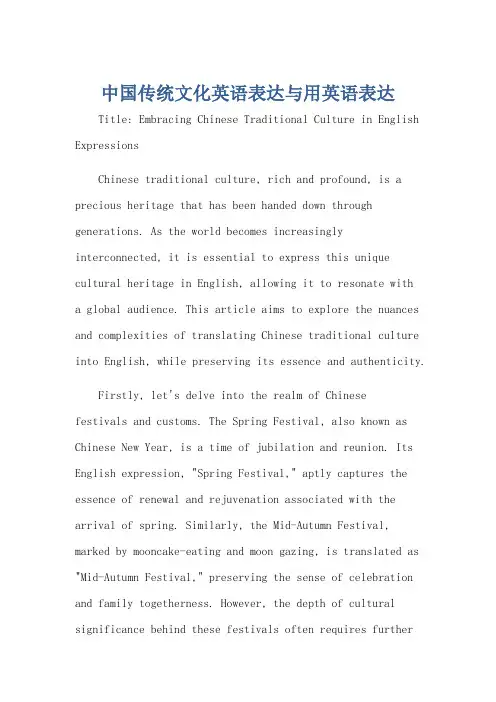
中国传统文化英语表达与用英语表达Title: Embracing Chinese Traditional Culture in English ExpressionsChinese traditional culture, rich and profound, is a precious heritage that has been handed down through generations. As the world becomes increasingly interconnected, it is essential to express this unique cultural heritage in English, allowing it to resonate witha global audience. This article aims to explore the nuances and complexities of translating Chinese traditional culture into English, while preserving its essence and authenticity. Firstly, let's delve into the realm of Chinesefestivals and customs. The Spring Festival, also known as Chinese New Year, is a time of jubilation and reunion. Its English expression, "Spring Festival," aptly captures the essence of renewal and rejuvenation associated with the arrival of spring. Similarly, the Mid-Autumn Festival, marked by mooncake-eating and moon gazing, is translated as "Mid-Autumn Festival," preserving the sense of celebration and family togetherness. However, the depth of cultural significance behind these festivals often requires furtherexplanation to ensure a comprehensive understanding for English speakers.In the realm of Chinese art and literature, the challenge of translation becomes even more pronounced. Poetry, in particular, is an art form that relies heavilyon rhyme, meter, and imagery. The beauty of Chinese poetry lies not only in its words but also in the emotional and philosophical depth they convey. Translating such poetryinto English requires a skilled translator who can capture the essence of the poem while respecting its original form and spirit. For instance, the famous line from Du Fu's poem, "会当凌绝顶,一览众山小," which translates to "One day I'll climb the loftiest peak, and survey all peaks beneath me small," attempts to convey the poet's ambition and grandeur, albeit with some loss of the original's rhythmic beauty.Moreover, Chinese philosophy and wisdom are integral parts of traditional culture. Concepts like "harmony," "yin and yang," and "the way of nature" are deeply ingrained in Chinese thought and practice. Translating these terms accurately and comprehensively into English is crucial for conveying their profound meanings. Terms like "harmony" areoften translated as "harmony" or "balance," while "yin and yang" are typically rendered as "yin-yang" or "the complementary opposites." While these translations provide a basic understanding, they may not fully capture the nuances and subtleties of these complex philosophical concepts.In addition to festivals, art, and philosophy, Chinese traditional culture also includes a rich tapestry of architectural styles and designs. The Forbidden City, the Great Wall, and the Temple of Heaven are just a few examples of the magnificent structures that embody Chinese architectural genius. Describing these structures in English requires a blend of historical knowledge, architectural terminology, and cultural sensitivity.Furthermore, Chinese traditional medicine, with its emphasis on holistic healing and natural remedies, is another fascinating aspect of culture worth exploring in English. Terms like "qi" (vital energy) and "acupuncture" (needle insertion) require careful and accurate translation to convey their meaning and application.In conclusion, expressing Chinese traditional culture in English is a complex yet rewarding task. It requires a deep understanding of both cultures, along with the skill and sensitivity to convey the essence and authenticity of the original. While translations may never be perfect, they can serve as bridges, connecting Chinese culture with the global community, fostering mutual understanding and appreciation. As we continue to explore and share our rich cultural heritage, we must strive to preserve its unique characteristics while adapting it to the language and understanding of others.。
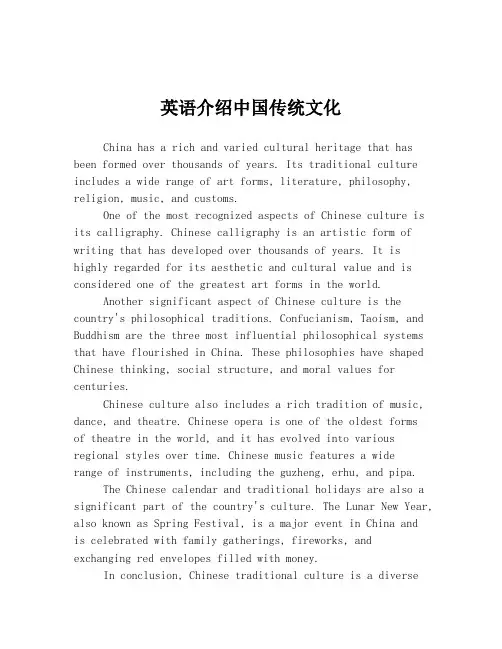
英语介绍中国传统文化China has a rich and varied cultural heritage that has been formed over thousands of years. Its traditional culture includes a wide range of art forms, literature, philosophy, religion, music, and customs.One of the most recognized aspects of Chinese culture is its calligraphy. Chinese calligraphy is an artistic form of writing that has developed over thousands of years. It is highly regarded for its aesthetic and cultural value and is considered one of the greatest art forms in the world.Another significant aspect of Chinese culture is the country's philosophical traditions. Confucianism, Taoism, and Buddhism are the three most influential philosophical systems that have flourished in China. These philosophies have shaped Chinese thinking, social structure, and moral values for centuries.Chinese culture also includes a rich tradition of music, dance, and theatre. Chinese opera is one of the oldest formsof theatre in the world, and it has evolved into various regional styles over time. Chinese music features a widerange of instruments, including the guzheng, erhu, and pipa.The Chinese calendar and traditional holidays are also a significant part of the country's culture. The Lunar New Year, also known as Spring Festival, is a major event in China andis celebrated with family gatherings, fireworks, and exchanging red envelopes filled with money.In conclusion, Chinese traditional culture is a diverseand multifaceted system of beliefs, art, philosophy, and customs. It has been shaped by thousands of years of history and has influenced the development of many other cultures around the world.。
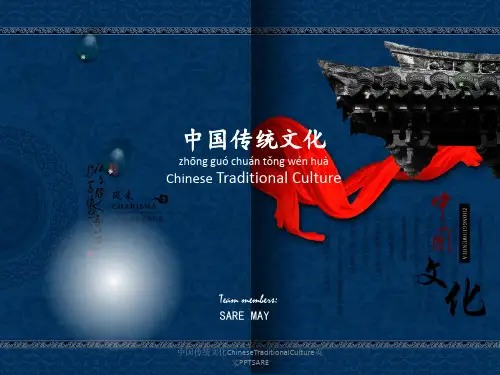
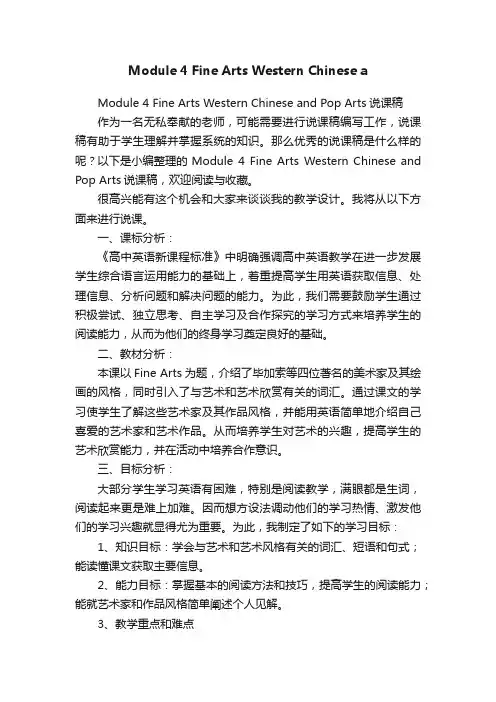
Module 4 Fine Arts Western Chinese aModule 4 Fine Arts Western Chinese and Pop Arts说课稿作为一名无私奉献的老师,可能需要进行说课稿编写工作,说课稿有助于学生理解并掌握系统的知识。
那么优秀的说课稿是什么样的呢?以下是小编整理的Module 4 Fine Arts Western Chinese and Pop Arts说课稿,欢迎阅读与收藏。
很高兴能有这个机会和大家来谈谈我的教学设计。
我将从以下方面来进行说课。
一、课标分析:《高中英语新课程标准》中明确强调高中英语教学在进一步发展学生综合语言运用能力的基础上,着重提高学生用英语获取信息、处理信息、分析问题和解决问题的能力。
为此,我们需要鼓励学生通过积极尝试、独立思考、自主学习及合作探究的学习方式来培养学生的阅读能力,从而为他们的终身学习奠定良好的基础。
二、教材分析:本课以Fine Arts为题,介绍了毕加索等四位著名的美术家及其绘画的风格,同时引入了与艺术和艺术欣赏有关的词汇。
通过课文的学习使学生了解这些艺术家及其作品风格,并能用英语简单地介绍自己喜爱的艺术家和艺术作品。
从而培养学生对艺术的兴趣,提高学生的艺术欣赏能力,并在活动中培养合作意识。
三、目标分析:大部分学生学习英语有困难,特别是阅读教学,满眼都是生词,阅读起来更是难上加难。
因而想方设法调动他们的学习热情、激发他们的学习兴趣就显得尤为重要。
为此,我制定了如下的学习目标:1、知识目标:学会与艺术和艺术风格有关的词汇、短语和句式;能读懂课文获取主要信息。
2、能力目标:掌握基本的阅读方法和技巧,提高学生的阅读能力;能就艺术家和作品风格简单阐述个人见解。
3、教学重点和难点难点:如何使学生学会自主、合作探究学习。
重点:1、掌握有关的词汇、短语和句式。
2、学会简单谈论自己喜欢的绘画作品。
3、情感态度和价值观:4、增进对国内外艺术家及其作品的了解,培养学生的艺术审美意识,陶冶学生的艺术情操。
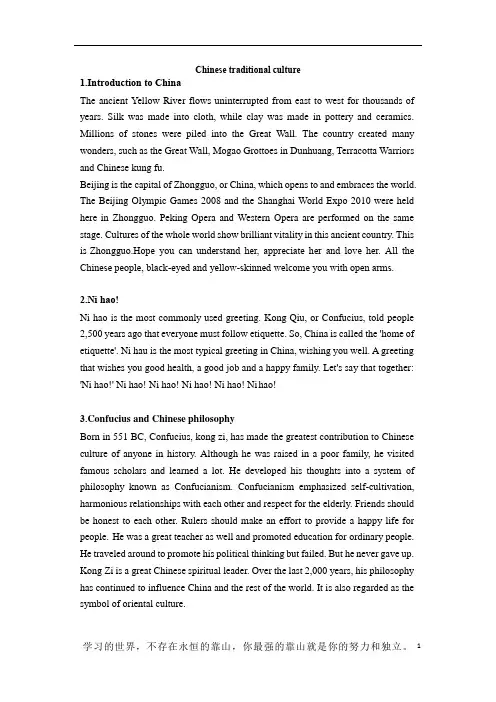
Chinese traditional culture1.Introduction to ChinaThe ancient Yellow River flows uninterrupted f ro m east to west for thousands of years. Silk was made into cloth, while clay was made in pottery and ceramics. Millions of stones were piled into the Great Wall. The country created many wonders, such as the Great Wall, Mogao Grottoes in Dunhuang, Terracotta Warriors and Chinese kung fu.Beijing is the capital of Zhongguo, or China, which opens to and embraces the world. The Beijing Olympic Games 2008 and the Shanghai World Expo 2010 were held here in Zhongguo. Peking Opera and Western Opera are performed on the same stage. Cultures of the whole world show brilliant vitality in this ancient country. This is Zhongguo.Hope you can understand her, appreciate her and love her. All the Chinese people, black-eyed and yellow-skinned welcome you with open arms.2.Ni hao!Ni ha o is the most commonly used greeting. Kong Qiu, or Confucius, told people 2,500 years ago that everyone must follow etiquette. So, China is called the 'home of etiquette'. Ni hau is the most typical greeting in China, wishing you well. A greeting that wishes you good health, a good job and a happy family. Let's say that together: 'Ni ha o!' Ni ha o! Ni ha o! Ni ha o! Ni ha o! Ni ha o!3.Confucius and Chinese philosophyBorn in 551 BC, Confucius, kong zi, has made the greatest contribution to Chinese culture of anyone in history. Although he was raised in a poor family, he visited famous scholars and learned a lot. He developed his thoughts into a system of philosophy known as Confucianism. Confucianism emphasized self-cultivation, harmonious relationships with each other and respect for the elderly. Friends should be honest to each other. Rulers should make an effort to provide a happy life for people.He was a great teacher as well and promoted education for ordinary people. He traveled around to promote his political thinking but failed. But he never gave up. Kong Zi is a great Chinese spiritual leader. Over the last 2,000 years, his philosophy has continued to influence China and the rest of the world. It is also regarded as the symbol of oriental culture.学习的世界,不存在永恒的靠山,你最强的靠山就是你的努力和独立。
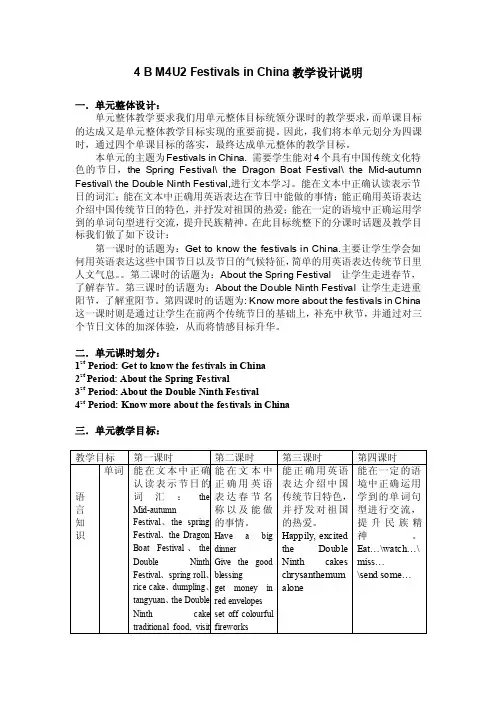
4 B M4U2 Festivals in China教学设计说明一.单元整体设计:单元整体教学要求我们用单元整体目标统领分课时的教学要求,而单课目标的达成又是单元整体教学目标实现的重要前提。
因此,我们将本单元划分为四课时,通过四个单课目标的落实,最终达成单元整体的教学目标。
本单元的主题为Festivals in China. 需要学生能对4个具有中国传统文化特色的节日,the Spring Festival\ the Dragon Boat Festival\ the Mid-autumn Festival\ the Double Ninth Festival,进行文本学习。
能在文本中正确认读表示节日的词汇;能在文本中正确用英语表达在节日中能做的事情;能正确用英语表达介绍中国传统节日的特色,并抒发对祖国的热爱;能在一定的语境中正确运用学到的单词句型进行交流,提升民族精神。
在此目标统整下的分课时话题及教学目标我们做了如下设计:第一课时的话题为:Get to know the festivals in China.主要让学生学会如何用英语表达这些中国节日以及节日的气候特征,简单的用英语表达传统节日里人文气息。
第二课时的话题为:About the Spring Festival 让学生走进春节,了解春节。
第三课时的话题为:About the Double Ninth Festival 让学生走进重阳节,了解重阳节。
第四课时的话题为: Know more about the festivals in China 这一课时则是通过让学生在前两个传统节日的基础上,补充中秋节,并通过对三个节日文体的加深体验,从而将情感目标升华。
二.单元课时划分:1st Period: Get to know the festivals in China2st Period: About the Spring Festival3st Period: About the Double Ninth Festival4st Period: Know more about the festivals in China三.单元教学目标:4 B M4U2 Festivals in ChinaLesson PlanPeriod 1Lesson Plan Period 2Lesson Plan 3。
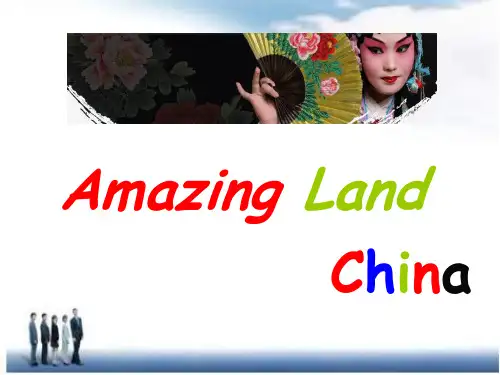
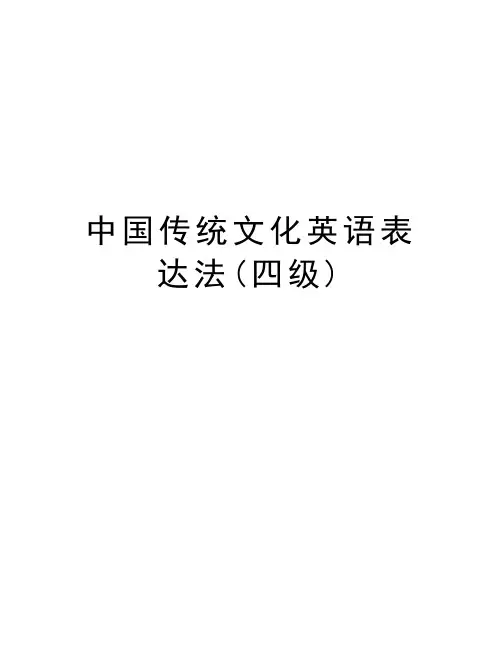
中国传统文化英语表达法(四级)Table Of contents中国传统节日Traditional Chinese Festivals (6)The Spring Festival 春节 (6)The Spring Festival Eve 除夕 (6)The Spring Festival Eve Dinner 年夜饭 (6)Spring Festival Couples 贴春联 (6)Gift Money 压岁钱 (6)Setting off firecrackers 放鞭炮 (6)Paying New Year Calls 拜年 (7)Vising Temple Fairs赶庙会 (7)The Lantern Festival 元宵节 (7)Eating Yuanxiao 吃元宵 (7)Watching Painted Lanterns 赏花灯 (7)Solving Lantern Riddles 猜灯谜 (7)The Dragon Boat Festival 端午节 (7)Qu Yuan (339BC? ~ 278BC?) 屈原 (8)Dragon Boat Racing 赛龙舟 (8)Eating Zongzi 吃粽子 (8)Hanging Moxa 挂艾蒿 (8)The Moon Festival 中秋节 (8)The Moon Cake 月饼 (8)The Double Ninth Festival 重阳节 (9)Climbing the Heights to Keep Away Troubles 登高避灾 (9)Appreciating the Chrysanthemums 赏菊 (9)Offering Sacrifices to the Goddess of the Sea 祭海神 (9)中国服饰Chinese Costumes (10)Silk 丝绸 (10)The Silk Road 丝绸之路 (10)The Maritime Silk Road 海上丝绸之路 (10)Cheongsam ['tʃɑŋsæm] (Qipao 旗袍) (10)The Making of Cheongsam ['tʃɑŋsæm] 旗袍的制作 (10)Modern Cheongsam 现代旗袍 (11)Modern Garments 现代服饰 (11)Chinese food中国饮食 (12)Beijing Cuisine and Snacks 北京菜与小吃 (12)The Roast Duck 北京烤鸭 (12)Instant-boiled Mutton 涮羊肉 (12)Manhan Quanxi 满汉全席 (12)Beijing Snakes 北京小吃 (12)Cantonese Cuisine and Snakes广东菜与小吃 (12)Seafood Dishes 海鲜菜 (13)Cantonese Snakes 广东小吃 (13)Sichuan Cuisine and Snakes 四川菜与小吃 (13)The Zhangcha Duck 樟茶鸭 (13)Mapo Doufu 麻婆豆腐 (13)Chinese Liquor 中国酒 (13)Yellow Wine 黄酒 (14)White Liquor 白酒 (14)Maotai Liquor 茅台酒 (14)Chinese Tea 中国茶 (14)The Home of Tea 茶叶的故乡 (14)Varieties of Tea 茶叶的品种 (14)Tea Ceremony 茶艺 (15)中国书法绘画 Chinese calligraphy and painting (15)The Four Treasures of the Study 文房四宝 (15)The Writing Brush 毛笔 (15)The Ink Stick 墨(块) (15)The Ink Slab 砚 (15)Traditional Chinese Paintings 中国画 (16)Landscape Paintings 山水画 (16)Flower-and-bird Paintings 花鸟画 (16)Figure Paintings 人物画 (16)New Year’s Painting 年画 (16)中国文物 (17)The Terra-cotta Warriors 秦始皇陵兵马俑 (17)The Underground Army 地下军阵 (17)Dunhuang Grottoes 敦煌石窟 (17)Cave Relief Murals 石窟壁画 (17)The Dunhuang Academy China 敦煌研究院 (17)中国民居Chinese Folk Residence (18)Cave Dwellings in Shaanxi 陕西窑洞 (18)Brick Caves and Stone Caves 砖窑和石窑 (18)Fujian Tulou 福建土楼 (18)The Ancestral Temple 祠堂 (18)Modern Private Houses 现代民居 (18)中华医药Chinese Medicine (20)Traditional Chinese Medical Science and Medicine中医中药 (20)The Diagnosis Method of Traditional Chinese Medicine 中医诊病 (20)Treatment of Diseases by Traditional Chinese Medicine中药治病 (20)Acupuncture and Moxibustion [,mɒksɪ'bʌstʃ(ə)n]艾灸Therapy 针灸疗法 (20)Acupuncture Therapy 针法治病 (20)Moxibustion Therapy 灸法治病 (21)Massage [mə'sɑʒ] therapy 按摩疗法 (21)中华武术The Chinese Martial Art (22)The Shaolin Martial Art 少林功夫 (22)Taiji Boxing太极拳 (22)The Origins of Taiji Boxing 太极拳源流 (22)中国文字The Chinese Character (23)The Evolution of Chinese Characters 汉字的演变 (23)The Origin of Chinese Characters 汉字的起源 (23)Standardization and Promulgation ([,promʌl'ɡeʃən] 宣传,普及) of Chinese Characters 汉字的规范与传播 (23)The Simplified Chinese Characters 简化汉字 (23)Beijing Language and Culture University (BLCU) 北京语言大学 (23)Confucius Institutes 孔子学院 (24)中国历史文化名城Famous Chinese Cities with Historical and Cultural Relics (25)The Ancient City Walls 古城墙 (25)Pingyao City in Shanxi 山西平遥 (25)Shaoxing City in Zhejiang 浙江绍兴 (25)Shaoxing: the City of Bridges 桥都绍兴 (25)The Black-awning Boat in Shaoxing 绍兴乌篷船 (26)Luxun Memorial Museum at His Former Residence 鲁迅故居纪念馆 (26)Fenghuang Town in Hunan 湖南凤凰 (26)Miao Ethnic Wax Printing 苗族蜡染 (26)Lijiang Town in Yunan 云南丽江 (26)The Ancient Streets 古街 (26)中国传统节日Traditional Chinese FestivalsThe Spring Festival 春节The Chinese Spring Festival falls on the very first day of the Chinese Lunar year. The celebration of the Spring Festival, otherwise known as the Chinese New Year, starts from the first day of the first lunar month and ends on the Lantern Festival, that is, the fifteenth of the month. T he Spring Festival to the Chinese is what Christmas to the Westerners (中国人过春节相当于西方人过圣诞节).The Spring Festival Eve 除夕The Spring Festival Eve, or the Chinese New Year’s Eve, is call the Danian Sanshi (大年三十)in Chinese. It is a time of jubilance, with eyeful of Spring Festival couplets, earful of loud firecrackers, and the kitchen full of yummy stuff cooking on the stove. Wherever they are, people will hurry back home for their family reunion on the eve.The Spring Festival Eve Dinner 年夜饭The Spring Festival Eve Dinner is known as the Dinner of Reunion. On the Eve, children away from home will all come back to enjoy a tableful of delicacies together with their parents. People in the north prefer jiaozi, the southerners like tangyuan, sweet round dumplings to indicate family reunion, and niangao, which means “going higher and higher in the coming year”.Spring Festival Couples 贴春联It has been a tradition for the Chinese to paste Spring Festival couples on the doors during the Festival. Words of auspiciousness are written in the couples, which are called duilian对联, or the Pair Couplets, b ecause the words on both couplets should be equal in number, parallel in form, and attuned in meaning. Sometimes people also paste a hengpi横批, a horizontal scroll bearing an inscription, above the couples. Gift Money 压岁钱On the festive occasion, young children will pay New Year calls on and express their best wishes to their elders who, in return, will offer them yasuiqian 压岁钱, money given to children as a Spring Festival gift.The money is usually wrapped up in red paper – a symbol of good fortune.Setting off firecrackers 放鞭炮Part of the Spring Festival celebration is to set off firecracker, which is meant to add joy to the festivity. People wish that, by setting off firecrackers, good luck would come to them in the coming year.Paying New Year Calls 拜年The Spring Festival is also a time to pay festive visits and say good wishes to one another among relatives, friends and neighbours.Vising Temple Fairs赶庙会During the Festival, people visit temple fairs, where an assortment of entertaining performances takes place, including Yandko秧歌 (a rirual folk dance popular in north China), acrobatics(杂技)and folk art shows. Varieties of snacks and commodity exchanges (商品交易)are also the integral parts of the fair.The Lantern Festival 元宵节The 15th day of the first lunar month is the Chinese Lantern Festival, which coincides with the first full-moon night of the year (这一天正好是新年的第一个月圆之夜). The major activities of the day include watching painted lanterns, solving riddles, setting off fireworks, and eating yuanxiao元宵(sweet dumplings) made of glutinous [ˈglu:tinəs](粘的,胶装的) rice flour(糯米面,糯米粉).Eating Yuanxiao 吃元宵Eating yuanxiao元宵on the day of the Lantern Festival symbolizes family reunion and happiness. Yuanxiao are made with glutinous rice flour dough, stuffed with a variety of food such as red bean paste, sesame, mixed nutlets with sugar. Minced meat is another favored flavor (元宵用糯米粉包馅制成,馅儿有豆沙、芝麻、各类果仁加白糖,还有肉糜馅等). In southern China, people also eat tangyuan汤圆(like yuanxiao元宵).Watching Painted Lanterns 赏花灯On the night of the Lantern Festival, lines of painted lanterns are hung around the courtyard and along both sides of the street. The colorful lights against the full moon create quite a visual feast for people to enjoy (人们观灯赏月,其乐融融).Solving Lantern Riddles 猜灯谜Solving riddles written or printed on lanterns is another way of entertaining visitors on the night.The Dragon Boat Festival 端午节The Chinese Dragon Boat Festival falls on the fifth day of the fifth month on the Chinese Lunar Calendar. The story goes that the day is kept in memory of the patriotic poet Qu Yuan屈原who died more than 2000 years ago. It’s also a day to pray for agricultural harvests as well as to drive pestilences [ˈpestiləns] away (同时也是人们祈求农业丰收,驱除瘟疫的节日).Qu Yuan (339BC? ~ 278BC?) 屈原Qu Yuan 屈原, a patriotic poet of the Chu State 楚国in ancient China, is greatly respected by people of all times, for both his fine poetry and noble character. It was on the fifth day of the fifth lunar month in the year 278 BC after the falling of the Chu State (楚国) that Qu Yuan (屈原)gave his life to his beloved motherland by drowning himself in the river (因楚国国都失陷,屈原悲愤地投江而死).Dragon Boat Racing 赛龙舟The dragon boat is made of wood, with mythical dragon head and dragon tail decorations on it. Dragon boat racing originally showed people’s wish to rescue Qu Yuan(屈原)from drowning, and gradually became a popular competitive mass sport (赛龙舟最初是表达屈原投江后,人们寻救他的迫切心情,后来逐渐成为端午节流行的一项民间体育竞技活动).Eating Zongzi 吃粽子Legend has it that in order to keep the fish away from eating Qu Yuan’s body, people would throw rice wrapped in bamboo or reed [ri:d](芦苇) leaves into the water to feed the fish. That’s how the tradition of eating zongzi 粽子(rice dumplings wrapped in leaves) around the Dragon Boat Festival started. A zongzi (粽子)is usually made in the shape of a triangular or square lump (粽子外形为三角形或四角形), wrapped in large bamboo leaves. The ingredients are mostly glutinous rice, beans, Chinese dates, or pork.Hanging Moxa 挂艾蒿Moxa leaves are hung in front of every household during the Dragon Boat Festival in order to expel[ɪk'spɛl](驱逐) evil spirits and to relieve people’s internal heat or fever (驱邪解毒). The sweet scent of the herb, however, can also repel flies and mosquitoes, and purify the air around the house.The Moon Festival 中秋节The Moon Festival or the Mid-autumn Festival falls on the 15th of the eighth month of the Chinese Lunar year. It is also called the Festival of Family Reunion 团圆节, as the full moon around that time very well symbolizes harvests and reunion. It is a time for family members to get together and savour['seivə]尽情享受moon cakes as they admire the full moon.The Moon Cake 月饼The Cake of Reunion 团圆饼 is another name for the moon cakes. Made by wheat flour dough and stuffed with a wide variety, sweet or salty,moon cakes are both the must-eat food and major gift items around the Moon Festival (月饼是中秋节人们互赠的主要礼品,也是节日的重要食品).The Double Ninth Festival 重阳节Chongyang重阳— the Double Ninth Festival, also known as the Senior Citizens’Day 老人节, is on the ninth of the ninth lunar month. As “nine” is regarded as a number of the Yang (positive or masculine by nature in Chinese philosophy), two “nines” together makes a Chongyang, or Double Yang (中国古人把九称为阳数,阳在中国哲学中属阳性,代表男性阳刚特质,所以九月九叫做重阳). On this day, people will go climbing mountains, drinking, and admiring chrysanthemum[kri'sænθəməm] 菊花 flowers. More importantly, it’s a time for children to show some tender loving care to the seniors or to show filial ['fɪlɪəl] piety ['paɪətɪ] for their parents. (filial peity 孝顺,孝心)Climbing the Heights to Keep Away Troubles 登高避灾The Double Ninth Festival is in autumn, when married women are supposed to observe the ritual of visiting their parents and taking them to do some mountain-climbing, so that they could enjoy the seasonal beauty together.Appreciating the Chrysanthemums 赏菊The chrysanthemums are in full blossom at this time of the year, and the great variety of the flower has long been the object of admiration for the Chinese (品种繁多的菊花在秋日盛开,观赏菊花是流传已久的节日风俗).Offering Sacrifices to the Goddess of the Sea 祭海神The ninth of the ninth lunar month happens to be the day when Mazu 妈祖, the Goddess of the Sea, ascended to the heaven. Grand ceremonies are held for her on the day in China’s coastal cities including the Taiwan Region.The God of Longevity [lɔn'dʒevəti]寿星老the guardian of long-life长寿的保护神中国服饰Chinese CostumesSilk and the silk road 丝绸与丝绸之路China has a long history of silk-worm-raising and silk-weaving(养蚕和丝织). Silk products from China were sold in great quantities to countries in the Middle East and Europe over 2000 years ago. The great impact of silk trading left its mark on the route and this route carrying the silk westwards was duly called the Silk Road (由于受丝绸贸易的巨大影响,运送丝绸西行的陆地贸易通道就被称作丝绸之路。
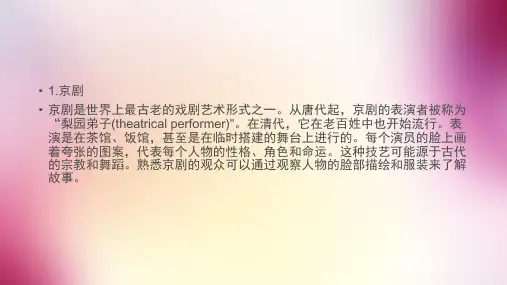
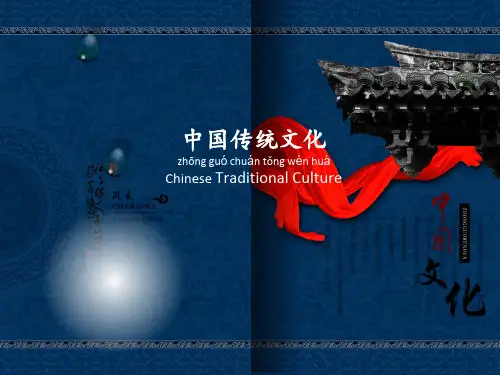
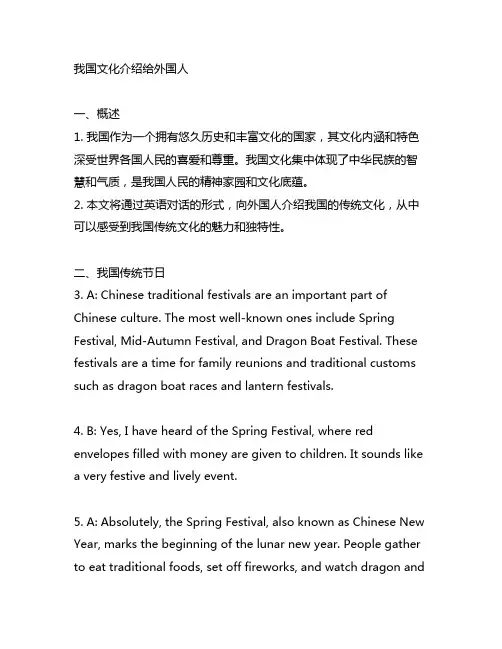
我国文化介绍给外国人一、概述1. 我国作为一个拥有悠久历史和丰富文化的国家,其文化内涵和特色深受世界各国人民的喜爱和尊重。
我国文化集中体现了中华民族的智慧和气质,是我国人民的精神家园和文化底蕴。
2. 本文将通过英语对话的形式,向外国人介绍我国的传统文化,从中可以感受到我国传统文化的魅力和独特性。
二、我国传统节日3. A: Chinese traditional festivals are an important part of Chinese culture. The most well-known ones include Spring Festival, Mid-Autumn Festival, and Dragon Boat Festival. These festivals are a time for family reunions and traditional customs such as dragon boat races and lantern festivals.4. B: Yes, I have heard of the Spring Festival, where red envelopes filled with money are given to children. It sounds like a very festive and lively event.5. A: Absolutely, the Spring Festival, also known as Chinese New Year, marks the beginning of the lunar new year. People gather to eat traditional foods, set off fireworks, and watch dragon andlion dances. It is a time for joy and celebration.6. B: I would love to experience these traditional festivals firsthand. It seems like a great way to learn more about Chinese culture and customs.三、我国传统艺术7. A: Chinese traditional art has a long history and diverse forms. Traditional Chinese p本人nting, calligraphy, and opera are all highly regarded art forms in China.8. B: I am especially interested in Chinese calligraphy. I have seen some beautiful Chinese calligraphy artworks and they are truly impressive.9. A: Chinese calligraphy is not only a form of artistic expression, but also a way to cultivate one's temperament and philosophy. Each stroke and character carries profound meanings and emotions.10. B: I can see how Chinese calligraphy requires a great deal of skill and patience. It is a truly unique art form that reflects the beauty of Chinese culture.四、我国传统饮食11. A: Chinese cuisine is famous for its variety of flavors, ingredients, and cooking techniques. Each region in China has its own distinct culinary traditions.12. B: I have tried some Chinese dishes like Peking duck and dim sum. The flavors are quite different from what I am used to, but I find them very delicious.13. A: Peking duck is a classic dish from Beijing, known for its crispy skin and tender meat. Dim sum, on the other hand, is a style of Chinese cuisine that features small, bite-sized portions of food traditionally served in small steamer baskets or on small plates.14. B: I would love to try more authentic Chinese dishes. It seems like Chinese cuisine has a lot to offer in terms of taste and variety.五、我国传统建筑15. A: Chinese traditional architecture is both functional and aesthetic. Ancient buildings like the Forbidden City and theGreat Wall are outstanding examples of traditional Chinese architecture.16. B: I have seen pictures of the Forbidden City and it looks truly magnificent. The intricate designs and elaborate decorations are truly impressive.17. A: The Forbidden City, also known as the Imperial Palace, was the Chinese imperial palace from the Ming dynasty to the end of the Qing dynasty. It is a symbol of traditional Chinese architecture and culture.18. B: I would love to visit these historical sites and learn more about Chinese traditional architecture. It would be a great way to appreciate the rich history and culture of China.六、我国传统服饰19. A: Traditional Chinese clothing, such as the qipao for women and the changshan for men, has a long history and unique style. The designs and patterns of traditional Chinese clothing reflect the essence of Chinese culture.20. B: I have seen traditional Chinese clothing in movies andthey look very elegant and sophisticated. The intricate embroidery and vibrant colors are truly captivating.21. A: Traditional Chinese clothing is not only a form of attire, but also a representation of Chinese culture and etiquette. It has evolved over thousands of years and continues to be a source of pride and identity for the Chinese people.22. B: I would love to try on traditional Chinese clothing and experience the beauty and grace of Chinese fashion. It seems like a great way to embrace the traditions and customs of China.七、我国传统文化的传承与发展23. A: Chinese traditional culture has been passed down through generations and continues to thrive in modern society. It is an integral part of the Chinese identity and has played a significant role in shaping the values and beliefs of the Chinese people.24. B: It's amazing to see how Chinese traditional culture has stood the test of time and rem本人ns relevant in today's world. It speaks to the resilience and enduring spirit of the Chinese people.25. A: Chinese traditional culture is constantly evolving and adapting to the changing times. It is a source of inspiration and pride for the Chinese people, and it continues to resonate with people around the world.26. B: I am truly fascinated by the depth and richness of Chinese traditional culture. It has given me a newfound appreciation for the heritage and legacy of China.结尾27. A: In conclusion, Chinese traditional culture is a treasure trove of history, art, and philosophy. It is a testament to the profound wisdom and creativity of the Chinese people, and it has left a lasting impact on the globalmunity.28. B: I am grateful for the opportunity to learn more about Chinese culture through this conversation. It has been an enlightening and inspiring experience.29. A: I hope that you will have the chance to visit China and immerse yourself in the beauty and splendor of Chinese traditional culture. It is a journey that is sure to leave a lastingimpression.30. B: Thank you for sharing your knowledge and insights about Chinese culture with me. I look forward to exploring more of what China has to offer in the future.以上为English dialogue的文章,约1424字。
以中国传统文化为主题的四级英语作文1. What is your understanding of traditional Chinese culture?Traditional Chinese culture is a rich and diversecultural heritage that has been passed down for thousandsof years. It encompasses various fields such as literature, art, philosophy, religion, and customs, and ischaracterized by its emphasis on harmony, balance, and respect for nature and tradition. It has influenced notonly China but also the world at large, and continues toplay a vital role in shaping the Chinese identity and wayof life.我对中国传统文化的理解是它是一种丰富多彩的文化遗产,已经传承了几千年。
它包括文学、艺术、哲学、宗教和风俗等各个领域,并以强调和谐、平衡、尊重自然和传统为特点。
它不仅影响着中国,而且影响着全世界,并继续在塑造中国人的身份和生活方式方面发挥着重要作用。
2. What are some of the most important elements of traditional Chinese culture?Some of the most important elements of traditional Chinese culture include Confucianism, Taoism, Buddhism, calligraphy, painting, poetry, opera, cuisine, and festivals. Confucianism emphasizes moral values such as filial piety, loyalty, and respect for elders, while Taoism emphasizes the pursuit of harmony with nature and the cultivation of inner peace. Buddhism, which was introduced to China from India, emphasizes the attainment of enlightenment and the relief of suffering. Calligraphy and painting are highly regarded art forms that express the beauty of Chinese characters and landscapes. Poetry and opera are also important cultural forms that convey the emotions and values of the Chinese people. Chinese cuisine is renowned for its variety, taste, and health benefits, while festivals such as the Spring Festival and Mid-Autumn Festival are important occasions for family reunions and cultural celebrations.中国传统文化中一些最重要的元素包括儒家思想、道家思想、佛教、书法、绘画、诗歌、戏曲、美食和节日。
用英语介绍中国传统文化pdf全文共3篇示例,供读者参考篇1Introduction to Traditional Chinese CultureChinese culture is one of the oldest and richest in the world, with a history that dates back thousands of years. It encompasses a wide range of traditions, customs, and practices that have been passed down through generations. In this document, we will explore some of the key aspects of traditional Chinese culture, including art, literature, philosophy, and food.ArtChinese art is diverse and multifaceted, encompassing a wide range of styles and mediums. Traditional Chinese painting, calligraphy, and pottery are highly esteemed for their beauty and elegance. Chinese artists often draw inspiration from nature, with landscapes, flowers, and animals being popular subjects. Traditional Chinese paintings are characterized by their use of brush strokes, ink washes, and vibrant colors.LiteratureChinese literature is one of the oldest and most influential in the world. The Chinese language is rich and expressive, allowing for a wide range of literary forms, including poetry, prose, and drama. Classic works such as "The Art of War" by Sun Tzu, "Journey to the West" by Wu Cheng'en, and "Dream of the Red Chamber" by Cao Xueqin are widely regarded as masterpieces of Chinese literature.PhilosophyChinese philosophy is deeply rooted in ancient texts such as the Confucian Analects, the Dao De Jing, and the works of Mencius. Confucianism, Daoism, and Buddhism are the three main philosophical traditions in China, each with its own unique beliefs and practices. Confucianism emphasizes moral values, filial piety, and social harmony, while Daoism focuses on living in harmony with nature and finding inner peace. Buddhism teaches the importance of compassion, mindfulness, and enlightenment.FoodChinese cuisine is known for its variety, flavor, and health benefits. Traditional Chinese cooking techniques includestir-frying, steaming, and braising, which help to preserve the natural flavors and nutrients of the ingredients. Popular ingredients in Chinese cuisine include rice, noodles, tofu,vegetables, and a wide range of meats and seafood. Some of the most famous Chinese dishes include Peking duck, dim sum, hot pot, and Mapo tofu.ConclusionTraditional Chinese culture is a rich and vibrant tapestry of art, literature, philosophy, and food. It has been shaped by thousands of years of history and continues to evolve and adapt in the modern world. By exploring the key aspects of Chinese culture, we can gain a deeper understanding of this ancient and fascinating civilization.篇2Introduction to Chinese Traditional CultureChinese traditional culture has a long history and has greatly influenced the development of Chinese society. It has accumulated and evolved over thousands of years, reflecting the wisdom, customs, values, and beliefs of the Chinese people. In this PDF, we will introduce some of the key aspects of Chinese traditional culture.1. ConfucianismConfucianism is a philosophical and ethical system that was founded by Confucius in the 5th century BC. It emphasizes the importance of moral values, social harmony, respect for elders, and the maintenance of proper relationships in society. Confucianism has had a profound impact on Chinese politics, education, and culture.2. TaoismTaoism is a philosophical and religious tradition that originated in China in the 4th century BC. It emphasizes living in harmony with the Tao, or the natural way of the universe. Taoist practices include meditation, martial arts, and the study of alchemy. Taoism has influenced Chinese art, literature, and medicine.3. Chinese CalligraphyChinese calligraphy is a highly esteemed art form in China that involves writing Chinese characters with a brush and ink. Calligraphy is considered a reflection of the calligrapher's personality and skill. It is often used in traditional Chinese painting, poetry, and seal carving.4. Chinese OperaChinese opera is a traditional form of performing arts that combines music, singing, acting, and acrobatics. There are several regional styles of Chinese opera, including Peking opera, Cantonese opera, and Sichuan opera. Chinese opera often depicts historical events, legends, and myths.5. Chinese FestivalsChinese festivals are an important part of traditional Chinese culture. Some of the most popular festivals include the Chinese New Year, the Lantern Festival, the Dragon Boat Festival, and the Mid-Autumn Festival. These festivals are celebrated with traditional customs, food, and performances.ConclusionChinese traditional culture is rich and diverse, encompassing a wide range of beliefs, practices, and art forms. It has been passed down from generation to generation and continues to be celebrated and cherished by the Chinese people. By studying and preserving Chinese traditional culture, we can gain a deeper understanding of the values and beliefs that have shaped Chinese society for centuries.篇3Chinese traditional culture is a rich and diverse heritage that has been passed down through generations. From literature and art to philosophy and customs, Chinese traditional culture encompasses a wide range of practices and beliefs that have shaped the country's identity.One of the most well-known aspects of Chinese traditional culture is Confucianism, a philosophy founded by Confucius that emphasizes the importance of ethical values such as benevolence, righteousness, and filial piety. Confucianism has had a profound influence on Chinese society, shaping everything from family relationships to government policies.Another important part of Chinese traditional culture is Chinese calligraphy, which is considered a high art form in China. Calligraphy has a long history in China, dating back thousands of years, and is prized for its beauty and expressiveness. Chinese calligraphy is not just a form of writing, but also a way of expressing one's emotions and personality.In addition to Confucianism and calligraphy, Chinese traditional culture also includes traditional Chinese medicine, martial arts, and traditional festivals such as the Chinese New Year and the Mid-Autumn Festival. These practices and beliefsare deeply rooted in Chinese society and continue to be celebrated and practiced by millions of people around the world.For those interested in learning more about Chinese traditional culture, there are many resources available, including books, websites, and PDF documents. These resources can provide valuable insights into the history, customs, and beliefs of Chinese traditional culture, allowing readers to gain a deeper understanding of this rich and vibrant heritage.In conclusion, Chinese traditional culture is a treasure trove of wisdom, artistry, and tradition that has been passed down through the ages. By exploring and learning about Chinese traditional culture, we can gain a greater appreciation for the values and beliefs that have shaped Chinese society for centuries.。
英语演讲稿四年级简单传统文化中国传统文化的英语演讲稿篇一:There are a lot of traditional culture in China, such as the Lantern Festival, the Dragon Boat Festival Dragon Boat Glutinous Rice Balls to eat, to celebrate the Mid Autumn Festival,summer egg fg..... I love most is the beginning of the egg fight.The day of the beginning, I invited my buddy to fight my eggs. At the beginning of theegg, mother prepared an egg for each of us and said, "who is the last of the eggs, who is the king of the egg!" First of all, I and Yao Peiyu, both of us egg head to the egg, who will not let anyone, to fight each other up. We just fight soon, they heard the click sound, there is abroken egg! I was so surprised that I looked at my eggs, and thank God, my eggs were notbroken.It was Yao Peiyu who accidentally hit the empty head with my tip! We saw it and laughed all the time. He bites and says, "come again!" This time, we all put out the strength ofthe milk, but his strength was not big, so he was defeated by me! Left Xiao Yuxuan, althoughshe is a girl, but not a good deal.All of a sudden,came up with a good plan and a seamless plan. I used to fight with heron the empty end and broke up in a moment.thought to myself, "this is the end of you.Your sharp head has been damaged. I will fight with you with a good and sharp tip." So, Itried to wipethe egg head, and suddenly blows, give strength to my eggs. At first, her eggswere damaged, and she was not so big as Iwas, so I was easily defeated. I jumped up withjoy. Mother loudly announced, "the end of the game, Sun Yize is the king of eggs!" Noweveryone begins to eat eggs. " We eat eggs, and all the people are in the atmosphere of joy.The egg not only brought us happiness, but also let me understand a truth: everything should be brain, with wisdom to win!中国传统文化的英语演讲稿篇二:Spring Festival is my favourite festival. This years Spring Festival is in February 8th. On New Years Eve, everyone will wear new clothes. My parents and I will go to the Grandpa and grandmas home to eat Nian Yefan. This is the tradition of our family.At the dinner table, my grandmother will prepare a lot of dishes for us to cook hot pot. These dishes are very delicious. Everyone ate very happy. We have forgotten the troubles of the past year, happy togreet the new year. After dinner, I will go back home with my parents. In eight,will be fireworks at the threshold of our home. They are very beautiful. Doing this will make me feel very happy.Afterput the fireworks, I will watch the Spring Festival Gala. The Gala adds a mood of celebration in the house as people laugh, discuss and enjoy the performance. At eleven, my parents gave me 200 yuan. This is my years newyears money. 0 ocolck, the new years bell sounded, we have ushered in the new year. I made a wish. I hoped that that we could have a happy and healthy life next year and everyone in my family could be happy.The first day of the new year, my father and I had the red antithetical Spring Festival couplets on our doors. Every Spring Festival, both urban and rural areas, each household must select a red couplets affixed to the door in order to increase the festive atmosphere.also cleaned the room with my mom. After the event, I will visit friends and relatives with my parents. This is the custom of the Chinese people to celebrate the Spring Festival.This is my Spring Festival holiday, I had a very happy. What about you?中国传统文化的英语演讲稿篇三:It is widely noted that lots of traditional culture is disappearing along with thedevelopment of technology. Many ancient architectures and traditional ways of living havebeen deserted. It seems that the traditional culture and craftsmanship will be replaced in this modern era.The following reasons can account for the above phenomenon.Firstly, traditional technologies are always considered ineffective while the new sciences are always highly efficient, because modern science and technology facilitate both our daily and academic life a lot, with which we can save much money and time. Secondly, it is costly to protect the traditional culture, especially the maintenance and repair of the historical buildings.In my opinion, although traditional culture is an ancient heritage, it couldnt keep pacewith the development of society. It is the tide of history that the traditional culture and technology will no doubt be eliminated in the end.。
新标准小学四年级英语Module4Chinesepeopleinventedpaper说课稿新标准小学四年级英语Module4 Chinese people invented paper说课稿一、教学目标与要求1、知识目标Words: important , paper , newspaper , invented , pringting , printedSentences: Paper is important.Chinese people invented …….Chinese people didn’t invent …….2、能力目标Help the students use these words and sentences in activities and daily life.Help the students to know some greating inventions.Help the students to learn the past indefinite tense.2、情感态度目标Inspire the students’ interest.Inspire the students to love our homeland .二、教学重点To master the basic sentence “Chinese people invented…….”To master the past indefinite tense “invent-invented , print-printed”To talk about what Chinese people invented.三、教学难点To talk about what Chinese people didn’t invent.To use these words and sentences in the past indenfinite tense correctly.四、课前准备Radio , cards , small pictures , multimedia五、教学过程Step 1 Warm up教师通过着急的找卡片的活动创设情境让学生感知important。
中国传统文化英语表达法(四级)中国传统节日Traditional Chinese FestivalsThe Spring Festival 春节The Chinese Spring Festival falls on the very first day of the Chinese Lunar year. The celebration of the Spring Festival, otherwise known as the Chinese New Year, starts from the first day of the first lunar month and ends on the Lantern Festival, that is, the fifteenth of the month. T he Spring Festival to the Chinese is what Christmas to the Westerners (中国人过春节相当于西方人过圣诞节).The Spring Festival Eve 除夕The Spring Festival Eve, or the Chinese New Year’s Eve, is call the Danian Sanshi (大年三十)in Chinese. It is a time of jubilance, with eyeful of Spring Festival couplets, earful of loud firecrackers, and the kitchen full of yummy stuff cooking on the stove. Wherever they are, people will hurry back home for their family reunion on the eve.The Spring Festival Eve Dinner 年夜饭The Spring Festival Eve Dinner is known as the Dinner of Reunion. On the Eve, children away from home will all come back to enjoy a tableful of delicacies together with their parents. People in the north prefer jiaozi, the southerners like tangyuan, sweet round dumplings to indicate family reunion, and niangao, which means “going higher and higher in the coming year”.Spring Festival Couples 贴春联It has been a tradition for the Chinese to paste Spring Festival couples on the doors during the Festival. Words of auspiciousness are written in the couples, which are called duilian对联, or the Pair Couplets, b ecause the words on both couplets should be equal in number, parallel in form, and attuned in meaning. Sometimes people also paste a hengpi横批, a horizontal scroll bearing an inscription, above the couples.Gift Money 压岁钱On the festive occasion, young children will pay New Year calls on and express their best wishes to their elders who, in return, will offer them yasuiqian 压岁钱, money given to children as a Spring Festival gift.The money is usually wrapped up in red paper – a symbol of good fortune.Setting off firecrackers 放鞭炮Part of the Spring Festival celebration is to set off firecracker, which is meant to add joy to the festivity. People wish that, by setting off firecrackers, good luck would come to them in the coming year.Paying New Year Calls 拜年The Spring Festival is also a time to pay festive visits and say good wishes to one another among relatives, friends and neighbours.Vising Temple Fairs赶庙会During the Festival, people visit temple fairs, where an assortment of entertaining performances takes place, including Yandko秧歌 (a rirual folk dance popular in north China), acrobatics(杂技)and folk art shows. Varieties of snacks and commodity exchanges (商品交易)are also the integral parts of the fair.The Lantern Festival 元宵节The 15th day of the first lunar month is the Chinese Lantern Festival, which coincides with the first full-moon night of the year (这一天正好是新年的第一个月圆之夜). The major activities of the day include watching painted lanterns, solving riddles, setting off fireworks, and eating yuanxiao元宵(sweet dumplings) made of glutinous [ˈglu:tinəs](粘的,胶装的) rice flour(糯米面,糯米粉).Eating Yuanxiao 吃元宵Eating yuanxiao元宵on the day of the Lantern Festival symbolizes family reunion and happiness. Yuanxiao are made with glutinous rice flour dough, stuffed with a variety of food such as red bean paste, sesame, mixed nutlets with sugar. Minced meat is another favored flavor (元宵用糯米粉包馅制成,馅儿有豆沙、芝麻、各类果仁加白糖,还有肉糜馅等). In southern China, people also eat tangyuan汤圆(like yuanxiao元宵).Watching Painted Lanterns 赏花灯On the night of the Lantern Festival, lines of painted lanterns are hung around the courtyard and along both sides of the street. The colorful lights against the full moon create quite a visual feast for people to enjoy (人们观灯赏月,其乐融融).Solving Lantern Riddles 猜灯谜Solving riddles written or printed on lanterns is another way of entertaining visitors on the night.The Dragon Boat Festival 端午节The Chinese Dragon Boat Festival falls on the fifth day of the fifth month on the Chinese Lunar Calendar. The story goes that the day is kept in memory of the patriotic poet Qu Yuan屈原who died more than 2000 years ago. It’s also a day topray for agricultural harvests as well as to drive pestilences [ˈpestiləns] away (同时也是人们祈求农业丰收,驱除瘟疫的节日).Qu Yuan (339BC? ~ 278BC?) 屈原Qu Yuan 屈原, a patriotic poet of the Chu State 楚国in ancient China, is greatly respected by people of all times, for both his fine poetry and noble character. It was on the fifth day of the fifth lunar month in the year 278 BC after the falling of the Chu State (楚国) that Qu Yuan (屈原)gave his life to his beloved motherland bydrowning himself in the river (因楚国国都失陷,屈原悲愤地投江而死).Dragon Boat Racing 赛龙舟The dragon boat is made of wood, with mythical dragon head and dragon tail decorations on it. Dragon boat racing originally showed people’s wish to rescue Qu Yuan(屈原)from drowning, and gradually became a popular competitive masssport (赛龙舟最初是表达屈原投江后,人们寻救他的迫切心情,后来逐渐成为端午节流行的一项民间体育竞技活动).Eating Zongzi 吃粽子Legend has it that in order to keep the fish away from eating Qu Yuan’s body, people would throw rice wrapped in bamboo or reed [ri:d](芦苇) leaves into the water tofeed the fish.That’s how the tradition of eating zongzi 粽子(rice dumplings wrapped in leaves) around the Dragon Boat Festival started. A zongzi (粽子)is usually made in the shape of a triangular or square lump (粽子外形为三角形或四角形), wrapped in large bamboo leaves. The ingredients are mostly glutinous rice, beans, Chinese dates, or pork.Hanging Moxa 挂艾蒿Moxa leaves are hung in front of every household during the Dragon Boat Festival in order to expel[ɪk'spɛl](驱逐) evil spirits and to relieve people’s internal heat or fever (驱邪解毒). The sweet scent of the herb, however, can also repel flies and mosquitoes, and purify the air around the house.The Moon Festival 中秋节The Moon Festival or the Mid-autumn Festival falls on the 15th of the eighth month of the Chinese Lunar year. It is also called the Festival of Family Reunion 团圆节, as the full moon around that time very well symbolizes harvests and reunion. It is a time for family members to get together and savour['seivə]尽情享受moon cakes as they admire the full moon.The Moon Cake 月饼The Cake of Reunion 团圆饼 is another name for the moon cakes. Made by wheat flour dough and stuffed with a wide variety, sweet or salty,moon cakes are both the must-eat food and major gift items around the Moon Festival (月饼是中秋节人们互赠的主要礼品,也是节日的重要食品).The Doubl e Ninth Festival 重阳节Chongyang重阳—the Double Ninth Festival, also known as the Senior Citizens’ Day 老人节, is on the ninth of the ninth lunar month. As “nine” is regarded as a number of the Yang (positive or masculine by nature in Chinese philosophy), two “nines” together makes a Chongyang, or Double Yang (中国古人把九称为阳数,阳在中国哲学中属阳性,代表男性阳刚特质,所以九月九叫做重阳). On this day, people will go climbing mountains, drinking, and admiring chrysanthemum[kri'sænθəməm] 菊花 flowers. More importantly, it’s a time for children to show some tender loving care to the seniors or to show filial ['fɪlɪəl] piety ['paɪətɪ] for their parents. (filial peity 孝顺,孝心)Climbing the Heights to Keep Away Troubles 登高避灾The Double Ninth Festival is in autumn, when married women are supposed to observe the ritual of visiting their parents and taking them to do some mountain-climbing, so that they could enjoy the seasonal beauty together.Appreciating the Chrysanthemums 赏菊The chrysanthemums are in full blossom at this time of the year, and the great variety of the flower has long been the object of admiration for the Chinese (品种繁多的菊花在秋日盛开,观赏菊花是流传已久的节日风俗).Offering Sacrifices to the Goddess of the Sea 祭海神The ninth of the ninth lunar month happens to be the day when Mazu 妈祖, the Goddess of the Sea, ascended to the heaven. Grand ceremonies are held for her on the day in China’s coastal cities including the Taiwan Region.The God of Longevity [lɔn'dʒevəti]寿星老the guardian of long-life长寿的保护神Chinese Tea 中国茶In China, tea-drinking is part of the Chinese culture: Tea Culture. To drink tea is not only a way of life, it is also a custom (喝茶不仅是人们生活中的一种习惯,也是待客的一种习俗). Teahouses where tea-drinkers could also socialize and entertain themselves are all over the country.Tea-sauteing (炒茶), the important part of tea processing, determines the quality of the product.The Home of Tea 茶叶的故乡Processed tea leaves picked from tea trees become the tea we prepare with water and then drink (茶是一种植物,称茶树,它的芽叶经过加工就成了可供冲泡的茶叶). Originally a product of China, tea was exported to parts of Asia as early as some 1500 years ago, and it arrived in Europe about 400 years ago.Varieties of Tea 茶叶的品种With different ways of processing, tea can be classified into such varieties as green tea 绿茶, black tea 红茶, oolong tea['uːlɒŋ]乌龙茶, and scented tea 花茶, etc. and under each category, there’re different brand names such as the Xihu Longjing西湖龙井(West Lake Longjing Tea, green tea produced in Hangzhou, Zhejiang 浙江杭州), Biluochun碧螺春(green tea, produced in Jiangsu Prov.江苏).Tea Ceremony 茶艺In the Chinese tea culture, there are certain rituals and rules to follow, either at the stage of preparing, drinking or treating a guest (沏茶,敬茶,饮茶). There’s also a set of criteria for the quality of water, tea, and tea-making utensils.中国书法绘画 Chinese calligraphy and painting The Four Treasures of the Study 文房四宝Wenfang文房refers to the study for a man of letters, and the tools and materials for calligraphy and painting include the writing brush, ink stick, ink slab and paper (笔、墨、纸、砚), so they are jointly called “the four treasures of the study”. In addition to these, there may also be other accessories for calligraphy and painting in the study, such as brush pots, brush racks, ink boxes, brush rinsing dishes, seals and seal boxes, ets (还有笔筒、笔架、墨盒、笔洗、印章、印盒等多种书法和绘画用品).The Writing Brush 毛笔Writing brushes are the traditional writing tools in China, dating from 1600 BC to 1066 BC. The point of the brush is usually made with hair from animal tails and the shaft of bamboo sticks. The sizes of writing brushes fall into three types, namely large,medium and small for writing characters of different sizes respectively (根据书写字体大小不同,毛笔有大、中、小号). There are also larger ones called Dou brush 斗笔or Ti brush 提笔, and the largest one is called Zha brush 揸笔.The Ink Stick 墨(块)In ancient China, people had to grind([graɪnd]磨碎,碾碎) the ink stick into ink liquid and then dip the writing brush into it to write and paint. For grinding the ink stick, some fresh water should be poured into the ink slab first, then, grind the ink stick round in one direction (用墨块在砚台上顺着一个方向研磨), and gradually, the fresh water turn into ink liquid.The Ink Slab 砚The ink slab, as a tool for grinding ink sticks and usually made of stone, is very important to an ancient man of letters in his study. The most famous is the Duan Ink Slab 端砚produced in Zhaoqing, Guangdong Province 广东肇庆, which is calledDuanzhou 端州in ancient times. This kind of ink slabs has a fine, soft and smoothtexture and the ink liquid ground in them is well mixed and durable (端砚质地细密柔润,研出的墨汁均匀耐用). Ink slabs can also be engraved with exquisite designs astreasures of art (砚台上还能雕出精美的花纹,成为艺术珍品).Traditional Chinese Paintings 中国画As a traditional art in China, traditional Chinese paintings are created through special manners of presentation and artistic principles, with writing brushes, ink, and pigment(色素颜料) which are all unique to the Chinese (国画是中国传统的绘画艺术,它用中国所独有的毛笔、水墨、颜料,以特有的表现形式和艺术法则创作而成). They can be classified, according to subject matter, into landscape, flower-and-bird and figure paintings.Landscape Paintings 山水画Landscape paintings mainly depict natural scenery of mountains and rivers, which first came into being in Qin Dynasty 秦代and reached a high level in Song Dynasty 宋代. Chinese landscape paintings attach great importance to pouring out the emotion of the artist and strive for an artistic acme of emotion being in harmony with scenery (中国山水画重在抒发画家个人情感,达到情景交融的艺术境界).Flower-and-bird Paintings 花鸟画Flower-and-bird paintings do not only depict flowers and birds only, but also bamboos, rocks, beasts, insects and fish (竹石、走兽、虫鱼) as well. What the artist advocates is that the depiction of these things could mould the personal temperament while embodying the internal moral character and the personal pursuit of the artist (画家主张通过对花鸟虫鱼的描绘,陶冶人的情操,体现作者内在的思想和追求).Figure Paintings 人物画Figure paintings focus particularly on the portrayal of the character’s activities, and the task of the artist is to draw out the pose and attire in lines for the purpose of conveying the romantic charm of the figure in the painting (画家用线条勾画出人物的形态和服饰,让人感受到画中人物的神韵). Ancient China has produced many great artists of figure paintings, such as Gu Kaizhi in Jin Dynasty 晋代的顾恺之, Wu Daozi in Tang Dynasty 唐代的吴道子, Tang Bohu in Ming Dynasty 明代的唐伯虎, and so on.New Year’s Painting 年画New Year’s painting is a kind of traditional Chinese paintings produced by means of woodcut process printing. As an old form of folk art in China, this kind of paintings all has festival themes and a sharp contrast in colors (年画是中国画的一种,它采用木刻套印的方法作画,内容喜庆、色彩对比强烈,是中国古老的民间美术形式). They are specially created for decoration of homes, warding off evil spirits and ominous occurrences in the celebration of the Chinese New Year (它是专门为过农历新年时装饰环境、除凶辟邪而创作的). That is why they are c alled New Year’s paintings.中国文物The Terra-cotta Warriors 秦始皇陵兵马俑Qin Shihuang 秦始皇, the first emperor of the feudal Chinese society, brought with him massive funerary belongings when he die — a move to show off the authority and splendor he’d enjoyed du ring his lifetime (秦始皇是中国封建社会的第一个皇帝。